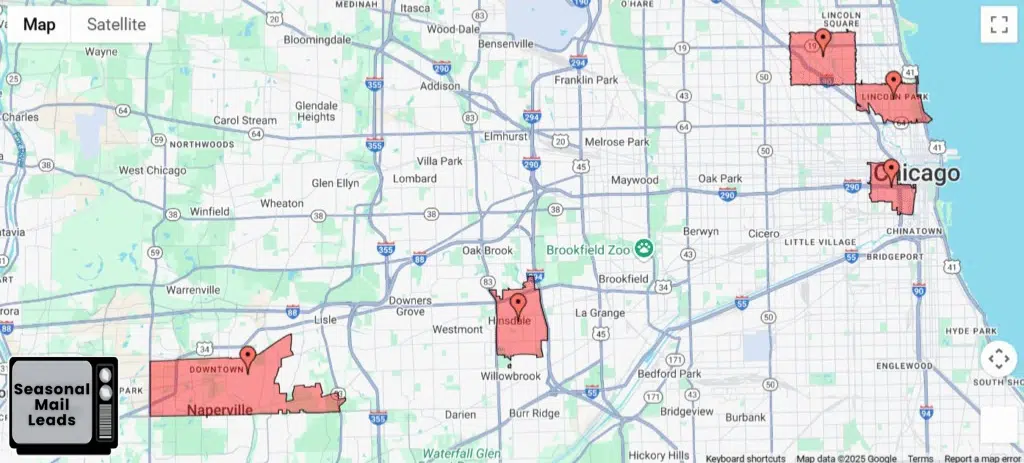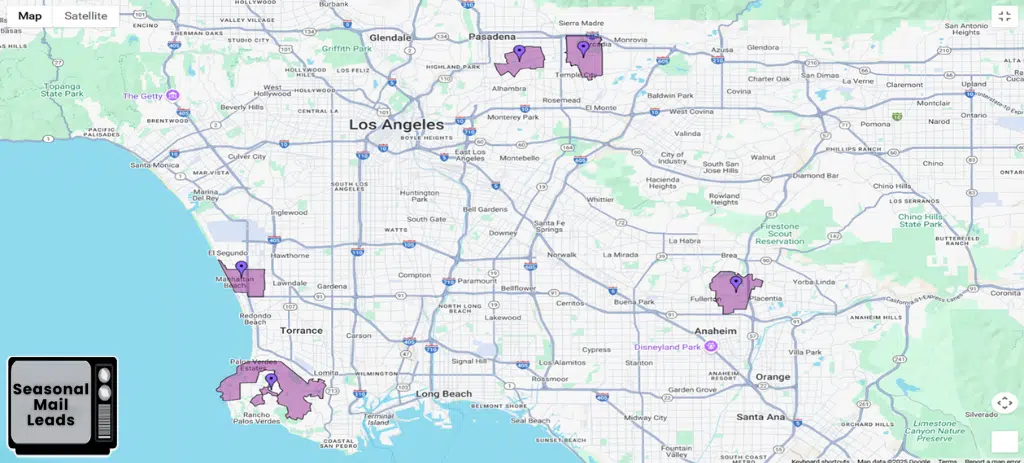
Enhancing ROI: Tracking & Improving Your Legal Direct Mail Campaigns – Data-Driven Success
Enhancing ROI: Tracking & Improving Your Legal Direct Mail Campaigns – Data-Driven Success
1. Introduction to Direct Mail Tracking for Law Firm Marketing
When one campaign generates twice as many calls as another, your direct mail tracking system immediately highlights the superior performer. This isn’t just about celebrating wins; it’s also about swiftly figuring out what doesn’t work. This lets you cut losses, change strategies, and avoid repeating ineffective approaches. These granular data insights are super valuable for refining your law firm marketing and ensuring every dollar spent helps you achieve successful legal lead generation. Through consistent performance analysis, you can achieve truly scalable marketing with your direct mail campaigns.
2. Justifying Your Marketing Spend: Clear ROI Data
In any business, especially a law firm, showing the value of every investment is key. Marketing budgets, in particular, often get a lot of scrutiny. Without clear Return on Investment (ROI) data, direct mail campaigns might seem like a hard-to-measure expense, especially when compared to digital channels that are easier to track.
Good tracking provides solid, measurable ROI data that lets you confidently show the direct value and profit from your direct mail investment. You can show important people (like partners or managing attorneys) not just how many mailers went out, but how many qualified leads they created, how many of those leads became paying clients, and the money those clients brought in for the firm. This changes direct mail from just a cost to a profit maker in your firm’s financial story. When you can say something clear like, “For every $1,000 spent on direct mail campaigns for X legal service, we generated $5,000 in new client revenue,” the talk about your marketing budget shifts from doubt to smart investment. This data empowers you to push for continued or even increased direct mail efforts, getting the resources you need for future client acquisition.
3. Continuous Improvement & Scaling for Scalable Marketing
The great thing about data is how it helps you make ongoing improvements. Direct mail tracking provides insights into how things are performing, leading to a cycle of constant enhancement and more efficient, scalable marketing campaigns. Think of it like a feedback loop: send, track, analyze, optimize, repeat. This process is key for effective legal lead generation.
Every campaign gives you new information. By looking at this data, you can spot trends, find unexpected insights, and pinpoint areas to improve. For example, you might discover that a certain type of legal case responds better to a specific offer, or that you get the most responses when mail is delivered on a particular day of the week. These insights aren’t set in stone; they change as the market, legal needs, and even your firm’s services change. By always using this data, you can:
- Improve Efficiency: Waste less money on things that aren’t working well.
- Boost Effectiveness: Make your offers and messages more appealing.
- Refine Targeting: Reach even more interested groups of people.
- Scale Confidently: Copy successful parts of your campaigns on a bigger scale, knowing they’re backed by proven results.
This ongoing process makes sure your direct mail campaigns don’t just succeed once, but keep evolving to reach their full potential, becoming a reliable way to get new clients.
4. Simple Systems for Tracking Legal Direct Mail Leads: Actionable Marketing Analytics
Setting up effective tracking doesn’t require super complicated or expensive software. Often, simple, well-thought-out systems can give you all the useful information your firm needs.
4.1. Unique Phone Numbers (Call Tracking)
For law firms, phone calls are usually the main way people get in touch. Giving specific, unique phone numbers to each direct mail campaign or even different versions within a campaign (like postcard A versus postcard B) is one of the easiest and most effective ways to track call volume and where calls come from.
How it works:
You can use special call tracking services that provide virtual phone numbers. When someone calls this number, it automatically forwards to your firm’s main line. The tracking service records details like:
- The campaign the call came from.
- The date and time of the call.
- Caller ID.
- How long the call lasted.
Some more advanced systems can even record calls (with proper notice), which helps with checking quality and figuring out if a lead is good.
Benefits:
- Precision: No guessing about where a call came from.
- Qualitative Data: Call recordings can give you insights into common questions, what clients need, and how well your front-desk staff handles calls.
- A/B Testing: Easily compare how many calls different mailer designs or offers get.
This method gives you precise data on direct responses to your mailers, helping you understand which specific pieces are driving phone engagement.
4.2. Dedicated Landing Pages with Tracking URLs
Sending mail recipients to specific, unique landing pages, each with its own tracking URL, is incredibly effective for measuring online activity that comes from your direct mail. This smoothly connects offline mail to online actions.
How it works:
Instead of sending people from your direct mail to your general website homepage, you send them to a specially designed landing page. For example, a mailer for personal injury leads might send them to yourfirm.com/pi-offer-summer2025.
To track specific mailers or groups, you can create unique URLs or add tracking details:
yourfirm.com/pi-offer-spring2025?source=mailer1yourfirm.com/pi-offer-spring2025?source=mailer2
Leveraging Your Existing Efforts:
This is where your past work really pays off! You mentioned that you created 260 landing pages by duplicating a template for your innovators.com business. This exact same approach is super powerful for direct mail. You can assign each of those 260 landing pages (or some of them) to a specific direct mail campaign, a particular mailer design, or even a smaller group on your mailing list. This allows for incredibly detailed tracking. For instance, if you have a unique landing page for each (e.g., seasonalmaileads.com/lp-001 seasonalmaileads.com/lp-001, seasonalmaileads.com/lp-002 seasonalmaileads.com/lp-002, etc.), you can easily see which specific mail pieces are driving traffic and sign-ups to those pages.
Benefits:
- Detailed Analytics: Track page views, how quickly people leave a page, time spent on page, and how many people complete an action (like filling out a form or downloading a document).
- Tailored Experience: Landing pages can be specifically designed for the offer or legal service in the mailer, which helps improve how many people complete the desired action.
- A/B Testing Online: Test different calls to action, form layouts, or content on different landing pages linked from different mailers.
Make sure these landing pages work well on phones, as many recipients might scan a QR code or type a URL on their mobile devices.
4.3. QR Codes & Unique Offer Codes
QR codes and unique offer codes add more ways to track, allowing you to link offline mail directly to online actions or specific offers.
QR Codes:
A QR code is a scannable image that, when scanned by a smartphone, takes the user to a specific website link.
How it works: Print a unique QR code on each direct mail piece or campaign. Each code points to a specific landing page or tracking URL. When scanned, software tracks the scan, and the user is taken to the chosen online page.
Benefits: Easy for the recipient (no typing URLs), direct link to online stuff, and you can measure how many scans you get.
Unique Offer Codes:
These are special letters and numbers printed on the mailer that recipients must use to get an offer, whether online or over the phone.
How it works: “Mention code ABC123 for a free 30-minute consultation” or “Enter code XYZ456 at checkout.” Your customer relationship management (CRM) system or intake team then records this code.
Benefits: Tracks direct responses to specific offers, can be used to A/B test different offers, and confirms where a lead came from.
Both methods provide concrete ways to link online actions or offer redemptions back to a specific piece of direct mail.
4.4. CRM Integration for Lead Management & Attribution Modeling
A Customer Relationship Management (CRM) system is like the central brain for managing your firm’s leads. Smoothly connecting direct mail campaigns leads into your CRM is vital for complete tracking and effective follow-up.
How it works:
- When a call comes in from a unique phone number, the lead is automatically recorded in the CRM, with the source already filled in.
- When a form is submitted on a dedicated landing page, the lead information is automatically sent into the CRM.
- If unique offer codes are used, your intake team manually enters the code into the CRM when the lead calls or visits.
Benefits:
- Holistic View: See the entire journey of a lead from the first contact (direct mail) through qualifying them, following up, and finally becoming a client.
- Improved Follow-Up: Automate tasks for follow-ups, schedule calls, and track communications all within the CRM.
- Attribution Reporting: Generate reports on which direct mail campaigns are creating the best leads and, eventually, clients.
- Sales Pipeline Management: Track how direct mail leads move through your firm’s intake and sales process.
CRM Integration is essential for turning raw data into useful information for your sales and marketing teams.
4.5. Surveying Clients on How They Found You
While automated tracking systems are powerful, don’t forget the value of simply asking new clients how they learned about your firm. This gives you valuable qualitative information that can confirm your tracking methods and uncover unexpected insights.
How it works:
- During the first meeting or onboarding, ask a standard question: “How did you hear about us today?”
- Provide a list of options that includes “Direct Mail” or specific campaign names.
- Encourage detailed answers: “Can you tell me more about the mailer you received?”
Benefits:
- Validation: Compare what clients say with your tracking data to make sure it’s accurate.
- Uncover Hidden Gems: Sometimes, clients might remember a mailer even if they didn’t use a specific tracking method, or they might mention something unique about the mailer that stuck with them.
- Feedback on Messaging: Client comments can give direct feedback on what parts of your direct mail message were most convincing.
- Reinforce Tracking: Reminds your intake team how important it is to identify where leads come from.
Combining these simple systems gives you a complete and accurate view of how your direct mail campaigns are performing.
5. Key Metrics for Direct Mail Success: Understanding Your Impact through Performance Metrics
Once you have your tracking systems in place, it’s time to analyze the data. Focusing on key measurements will help you truly understand the impact and profitability of your direct mail campaigns.
5.1. Response Rate
The response rate is the most basic measurement for direct mail. It shows the percentage of people who take a desired action after getting your mailer.
Calculation:
Response Rate = (Number of Responses ÷ Number of Mailers Sent) × 100%
What it tells you:
- How appealing your offer and message are to your target audience.
- How effective your call to action is.
- The initial interest your mail piece generated.
A “response” can be a phone call (tracked by unique numbers), a website visit (tracked by unique URLs or QR codes), filling out a form, or using an offer code. A higher response rate means a more effective mailer and a better fit with your audience.
5.2. Lead-to-Client Conversion Rate
While a high response rate is good, it’s not enough if those leads don’t become paying clients. The lead-to-client conversion rate measures how well leads specifically from your direct mail efforts turn into actual clients for your firm.
Calculation:
Lead-to-Client Conversion Rate = (Number of Clients Acquired from Direct Mail ÷ Number of Leads Generated from Direct Mail) × 100%
What it tells you:
- The quality of the leads your direct mail campaigns create.
- How effective your firm’s intake and sales process is at turning those leads into clients.
- Whether your direct mail is attracting the right kind of potential client.
A low conversion rate from good quality leads might mean there are issues in your intake process, while a high conversion rate suggests your mailers are reaching the right people and your firm is good at helping them.
5.3. Cost Per Lead (CPL)
The Cost Per Lead (CPL) is a very important efficiency measurement. It tells you on average how much it costs your firm to get one lead from your direct mail campaign.
Calculation:
Cost Per Lead (CPL) = Total Direct Mail Campaign Cost ÷ Total Number of Leads Generated from Campaign
What it tells you:
- How efficient your campaign is at generating initial interest.
- Allows you to compare the cost of getting leads across different direct mail campaigns or even against other marketing methods (like online ads or social media ads).
A lower CPL is usually better, meaning you’re getting leads more cost-effectively. Understanding CPL helps you optimize your campaigns to get more leads for your budget.
5.4. Cost Per Acquisition (CPA)
The Cost Per Acquisition (CPA), sometimes called Cost Per Client Acquisition (CPCA), is arguably the most important efficiency measurement for your law firm. It represents the total marketing cost tied to getting one new paying client.
Calculation:
Cost Per Acquisition (CPA) = Total Direct Mail Campaign Cost ÷ Number of New Clients Acquired from Campaign
What it tells you:
- The real cost of bringing in a new paying client through direct mail.
- Helps figure out if your direct mail campaigns efforts are sustainable and profitable in the long run.
Your CPA must be significantly lower than the average value a client brings to your firm over their lifetime to ensure you’re making money. For a personal injury firm, a CPA of $500 to get a client whose case generates $5,000 in fees is fantastic. For an estate planning firm where the average client value is $2,000, a CPA of $1,000 might be okay. This measurement directly links your marketing spending to the revenue you make.
5.5. Return on Investment (ROI)
The ultimate measure of profitability, ROI, compares the money you make from your direct mail campaign to its total cost. It answers the question: “How much money did we make for every dollar we spent?”
Calculation:
ROI = ((Revenue Generated from Direct Mail Clients – Total Direct Mail Campaign Cost) ÷ Total Direct Mail Campaign Cost) × 100%
What it tells you:
- The overall profitability of your direct mail campaign.
- The direct financial impact of your marketing efforts.
A positive ROI means your campaign made more money than it cost. A higher ROI means more profit. For law firms, calculating the revenue from direct mail clients involves understanding the average case value for the types of leads your campaign generates. For example, if a campaign costs $10,000 and brings in 5 new clients, each generating an average of $3,000 in fees, the revenue is $15,000.
Let’s do the math:
- Revenue Generated: $5 clients * $3,000/client = $15,000
- Total Campaign Cost: $10,000
- Profit (Revenue – Cost): $15,000 – $10,000 = $5,000
- ROI Calculation: ($5,000 ÷ $10,000) × 100% = 50%
This means for every dollar spent, you got $1.50 back, which is a 50% profit. Consistently positive ROI is a sign of a successful, data-driven direct mail strategy.
6. Optimizing Your Campaigns for Maximum Lead Conversion & Campaign Optimization
Tracking gives you the information; optimization is about using that information to constantly improve performance. It’s an ongoing process that refines your approach for the best possible lead conversion and, ultimately, profit.
6.1. A/B Testing
A/B testing (also called split testing) is a basic way to improve things. It involves creating two (or more) versions of a mailer or something inside it, sending them to similar groups of your target audience, and seeing which one works better based on your key measurements.
What to A/B test:
- Offers: Like “Free Consultation” versus “Case Evaluation Checklist” versus “No Fee Unless We Win.”
- Headlines: Such as “Injured in an Accident?” versus “Get the Compensation You Deserve.”
- Calls to Action (CTAs): Like “Call Now” versus “Visit Our Website” versus “Scan for More Info.”
- Design & Layout: Different colors, image choices, font sizes, or how the postcard is oriented.
- Personalization: The impact of including the recipient’s name or specific details.
- Envelope Style: Windowed versus solid, handwritten versus printed addresses.
By constantly testing one thing at a time, you can systematically find the most effective elements. A/B testing isn’t a one-time thing; it should be an ongoing process as market conditions and client preferences change.
6.2. Refining Target Audiences with Targeting Strategies
Performance data is your most powerful tool for fine-tuning who you send mail to. Instead of sending broadly, use your tracking insights to focus on the groups that respond best.
How to refine:
- Demographic Data: If your data shows that certain age groups, income levels, or geographic areas respond much better, adjust your future mailing lists to prioritize these groups.
- Behavioral Data (if available): If you target based on specific public records (like recent property sales or certain legal events), analyze which of these events leads to the highest conversion rates.
- Suppression Lists: Keep your “do not mail” lists updated for people who have already responded (and become clients, or asked not to be contacted again) or for those who consistently show no interest.
- Lookalike Audiences: Once you know the characteristics of your best-performing group, you can often work with data providers to find “lookalike” audiences with similar traits, expanding your reach to high-potential prospects.
Precise targeting strategies reduce wasted mail, improve response rates, and ultimately lower your Cost Per Lead (CPL) and Cost Per Acquisition (CPA).
6.3. Follow-Up Strategies for Leads
A well-designed direct mail campaign piece can create a lead, but it’s your follow-up plan that turns that lead into a client. Strong follow-up procedures are essential for nurturing leads and maximizing conversion rates.
Elements of effective follow-up:
- Speed: Respond to inquiries (calls, form submissions) immediately. The faster you respond, the higher the conversion rate.
- Multi-Channel Approach: Don’t just rely on phone calls. Set up a sequence that might include:
- Immediate phone call.
- A follow-up email with helpful information.
- A personalized text message (if you have permission).
- Even a follow-up “thank you” or “information packet” mailer.
- Persistence: It often takes several attempts to convert a lead. Develop a systematic plan to nurture leads that don’t immediately convert.
- Personalization: Make your follow-up communication specific to the legal need indicated by the mailer or the first inquiry.
- CRM Automation: Use your CRM to automate reminders for follow-ups, track communications, and move leads through your firm’s intake process.
Even a great direct mail campaign can fail because of poor follow-up. Improving this crucial step directly affects your lead-to-client conversion rate and overall ROI.
6.4. Budget Allocation Based on Performance
Data-driven growth means making smart decisions about where to spend your marketing money. Put more resources into the campaigns and strategies that prove most effective, and reduce or stop those that don’t perform well.
How to do it:
- Analyze CPA and ROI by Campaign/Segment: Regularly check the Cost Per Acquisition (CPA) and Return on Investment (ROI) for each direct mail campaign or even different parts of a campaign.
- Shift Spending: If one campaign consistently delivers a lower CPA and higher ROI, put a bigger part of your budget into that strategy. On the flip side, spend less on campaigns with high CPAs or negative ROI.
- Test New Avenues: Use a small part of your budget for experimental campaigns or new target groups, and if they work, scale them up.
- Seasonal Adjustments: If your data shows certain legal services or mailer types perform better during specific seasons (e.g., bankruptcy filings after holidays, personal injury claims in summer), adjust your budget accordingly.
This smart allocation makes sure your marketing budget is always working as hard as possible for your firm, maximizing efficiency and profitability.
7. Seasonal Mail Leads’ Role in Your ROI Success: Your Optimization Partner
Figuring out direct mail tracking and optimization can be tough, especially for busy law firms. Seasonal Mail Leads acts as your dedicated partner, providing the tools, expertise, and support needed to make sure your direct mail campaigns consistently deliver maximum ROI.
7.1. Providing Trackable Assets
We don’t just print and send mail; we give you the basic tools for precise measurement.
- Unique Design Elements: We can put unique phone numbers directly into the design of your mailers.
- QR Code Generation: We help you create and place unique QR codes that link to your dedicated landing pages or other online content.
- Guidance on Offer Codes: We advise on the best ways to include and track unique offer codes within your mail pieces.
- Streamlined Data Integration: We work with you to make sure the data from your direct mail is easy to understand and works with your CRM or existing marketing analytics platforms.
Our goal is to make the technical parts of tracking as smooth as possible, letting your firm focus on nurturing leads and serving clients.
7.2. Consultation on Performance Analysis
Raw data is only valuable if you can turn it into useful information. Our experts are here to help you understand your campaign results.
- Data Interpretation: We don’t just give you numbers; we help you understand what those numbers mean for your firm’s goals.
- Identifying Trends: Our team helps you spot patterns, find high-performing segments, and figure out areas to improve that might not be immediately obvious.
- Custom Reporting: We can help you set up reports that highlight the key measurements most important for your firm’s decisions.
We act as an extension of your analytical team, giving you the clarity you need to make smart strategic choices.
7.3. Partnership in Campaign Optimization
Campaign optimization is a continuous journey, not a final stop. Seasonal Mail Leads is committed to working with your firm to constantly refine and improve your direct mail campaigns for ongoing, profitable growth.
- A/B Test Design: We work with you to design effective A/B tests, making sure that variables are isolated and results are statistically significant.
- Audience Refinement: Based on performance data, we help you fine-tune your target audienceselection, ensuring your mail reaches the most receptive potential clients.
- Content and Offer Adjustments: We provide recommendations for adjusting your mailer content, offers, and calls to action based on what the data shows, including considering keyword optimization for any online content you link to.
- Strategic Planning: We work with you to develop long-term direct mail plans that include continuous optimization, ensuring your campaigns become more efficient and profitable over time.
We are invested in your success, treating your campaigns not as one-off projects, but as evolving strategies for continuous improvement.
8. Anticipate Your Success: Law Firm Growth with Seasonal Mail Leads
Discover the kind of transformative client acquisition we’re committed to delivering for your law firm. These scenarios illustrate the powerful outcomes our partners can expect leveraging Seasonal Mail Leads for their legal marketing strategy.
- For Estate Law Practices: Imagine your firm’s legal lead generation being revolutionized. We aim to provide exclusive new homeowner postcards that consistently bring in highly qualified clients for your estate planning marketing, making it effortless for you to focus on your legal work with our direct mail services.
- For Family Law Firms: Envision a significant boost in your family law inquiries. With Seasonal Mail Leads, our goal is for your precise targeting strategies and professional postcard designs to create an attorney marketing campaign that consistently exceeds your expectations, just like our top performers.
- For Tax & HOA Law Specialists: Expect quick, easy, and incredibly effective connections with homeowners needing tax law guidance or navigating HOA & CC&R challenges. Our commitment is to ensure Seasonal Mail Leads becomes an indispensable part of your law firm’s marketing needs, helping you secure new clients efficiently.
9. Start Your Summer Legal Leads Campaign Today
Secure your exclusivity. Limited spots available per city for law firm marketing.
- 10-Week Program: Designed for steady call flow & bar association compliance.
- Exclusive Access: Limited spots per city/area to protect your market for attorney leads.
- Two Plans: New Client Plan & Returning Client Renewal for postcard marketing campaigns.
Pricing Snapshot:
- New Client Plan: Just $103.99 every week (total 16 weeks).
- Returning Client Renewal: Only $83.99 every week (total 16 weeks).
10. Call to Action
Are you ready to stop guessing and start knowing the true impact of your legal direct mail? Are you prepared to master your direct mail ROI and drive data-driven growth for your firm?
Take the next strategic step with Seasonal Mail Leads:
- Request Your FREE Sample Postcard. Start your journey toward measurable results by seeing the quality and potential of our compliant designs. This no-obligation sample offers a real first step to understanding how our approach can work for your firm.
- Get a Strategy Session on Tracking & Optimization with Our Experts Today. Don’t leave your firm’s growth to chance. Schedule a confidential chat with our experienced specialists. We’ll look into your specific marketing goals, discuss the exact tracking methods we can use for your campaigns, and map out a customized campaign optimization strategy designed to give you complete peace of mind and maximize your ROI. Let us show you how our proactive partnership can boost your marketing and protect your firm’s profitability.
11. Conclusion
In today’s competitive legal world, just relying on a hunch for marketing means you’ll likely fall behind. Tracking and optimization aren’t just extra features; they transform direct mail from a simple, often hard-to-measure mailing into a sophisticated, predictable way to get clients. By carefully measuring every touchpoint, analyzing performance metrics, and constantly refining your strategies, your firm can move beyond guessing and embrace real data-driven growth.
Seasonal Mail Leads is dedicated to partnering with your firm to ensure measurable results, driving sustainable and profitable growth through smart, data-driven direct mail campaigns. We provide the expertise, tools, and ongoing support needed to not only understand your direct mail’s impact but to continuously improve it. Let us help you unlock the full potential of direct mail, turning every mail piece into a strategic investment that builds trust, strengthens your reputation, and most importantly, fuels the predictable acquisition of new, valuable clients for your firm.






